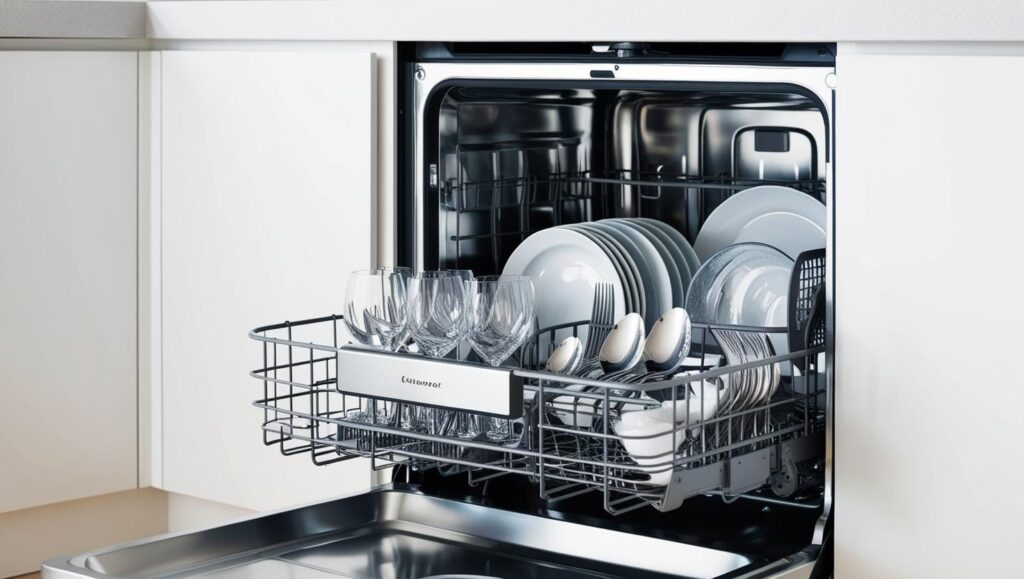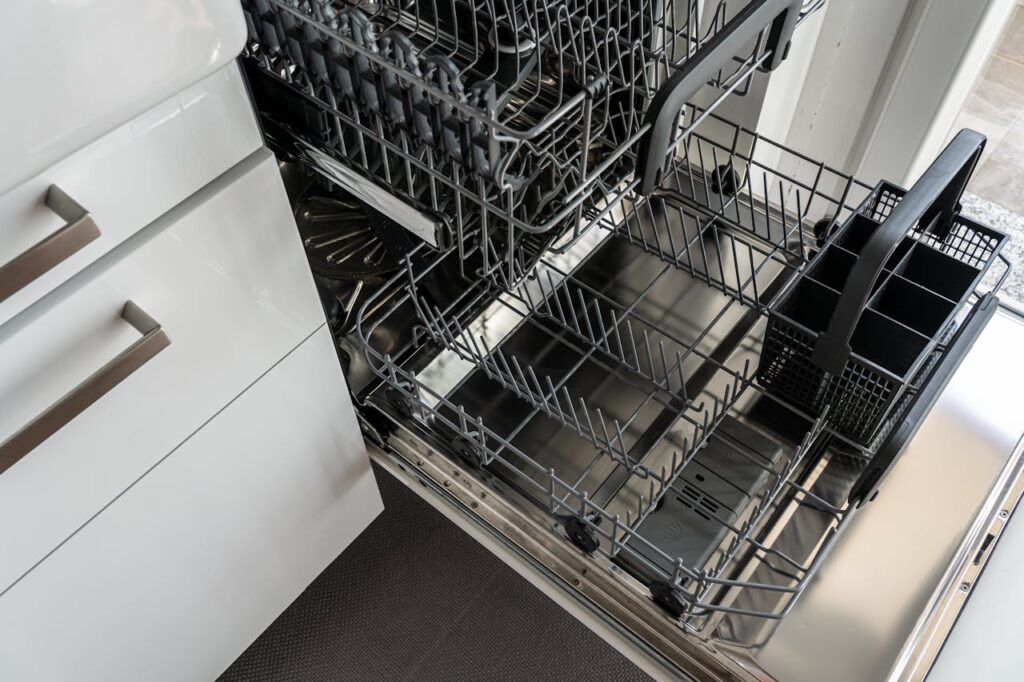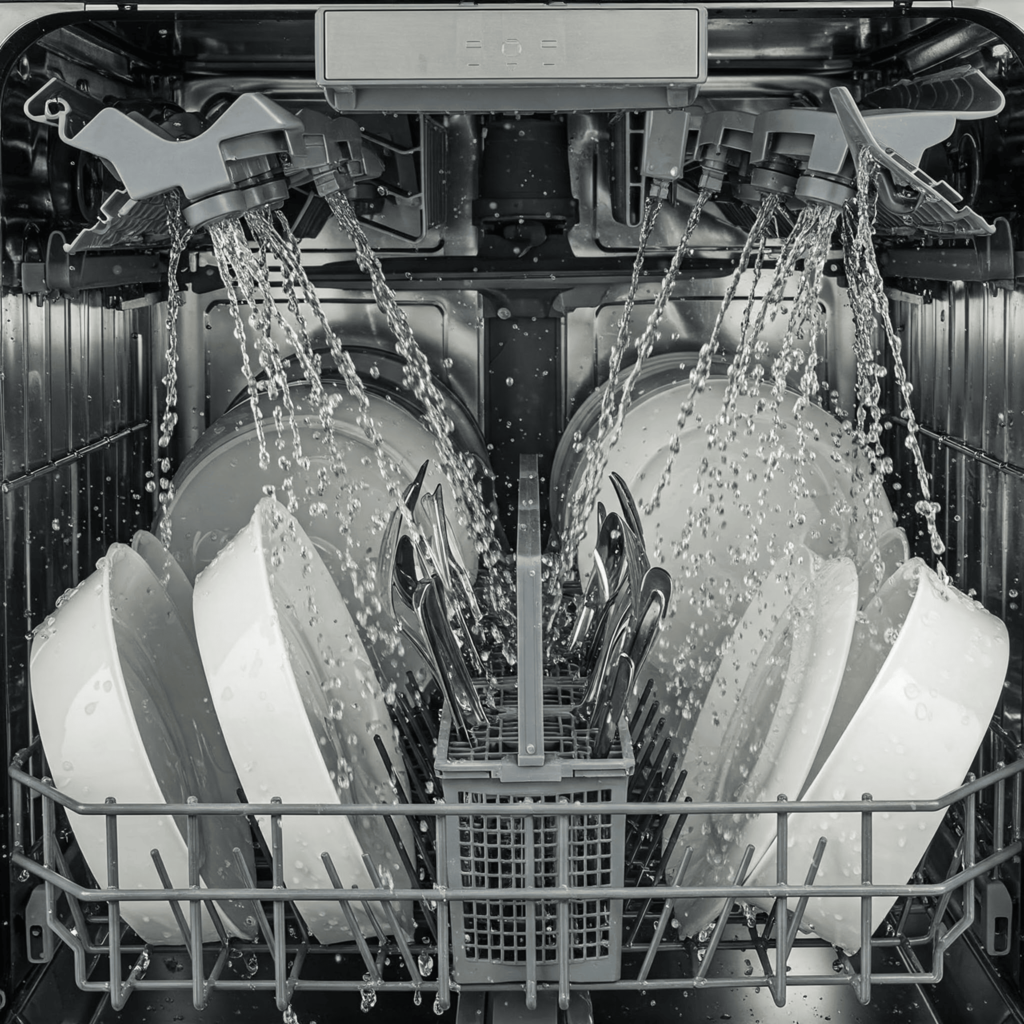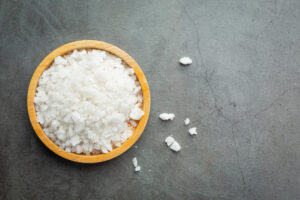
Pre-Soak – Make Cleaning Easier from the Start:
After having meals or cooking, dispose any leftover food debris in the dustbin. Then, place the used dishes and utensils in the sink to soak. Soaking the dishes makes the cleaning process easier and more effective.
If you forget to soak the dishes, don’t worry—your dishwasher’s pre-rinse feature handles it with ease. This feature loosens tough stains, getting your dishes ready for the main wash cycle that comes next.
Effortless Dishwashing – Step-by-Step Instructions:
1. Prepare and Group Your Dishes:
Before loading, remove any excess food debris from the dishes. Then, sort the utensils to make the loading process easier:

Group Similar Items Together:
Group similar items together, such as cutlery, strainers, pressure cooker parts, tumblers, plates, small vessels and large vessels.
Set Aside Non-Dishwasher-Safe Items:
Set aside non-dishwasher-safe items to avoid damage and hand wash them separately.
Following this method simplifies the loading process and helps save time overall.
2. How to Load a Dishwasher Correctly for Spotless Cleaning:
Open the dishwasher and pull out the racks to start arranging the dishes. The number of racks and whether there is a cutlery stand can vary depending on the model and brand of your dishwasher.


Arrange and Position the Dishes:
- Place all cutlery in the designated cutlery rack, or in the cutlery stand if a rack is not available.
- Arrange plates and larger vessels on the bottom rack.
- Smaller items like tumblers, small vessels, and small cups will go in the top rack.
Tips for Proper Loading:
- Group similar items together, ensuring proper spacing between them to allow water and detergent to circulate effectively.
- Always load items upside down to prevent water and detergent from collecting inside.
- Make sure to place small items like spoons and plates properly in the rack to avoid them falling and blocking the dishwasher’s spray arms.
Once you’ve loaded everything, double-check that you’ve placed all items and pushed the racks securely back into place.
3. Ensure the Spray Arms Spin Freely:
After loading, ensure no dishes or utensils obstruct the spray arms. The spray arms rotate and use small holes to distribute water and detergent evenly across the dishes.
If the spray arms can’t rotate properly, they interrupt water flow and prevent the detergent from dissolving effectively.. This can result in poor cleaning, potentially requiring another wash cycle.
Always ensure the spray arms can spin freely to guarantee optimal cleaning performance.
4. Fill the Detergent Dispenser:
After checking the spray arms, ensure you fill the detergent, salt, and rinse aid properly. Salt and rinse aid usually don’t need refilling after every wash, as they last for 10-15 washes, while detergent must be added for each wash.
Filling Instructions:
- You can use any form of detergent: tablets, powder, or gel -whichever suits your preference. Regardless of the form, it’s important to fill the dispenser with the correct amount of detergent. Too little detergent may leave your dishes dirty, while too much can result in soapy residue or detergent build up on your dishes.
- Refill the salt and rinse aid as needed when the control panel indicates.


Always make sure you close all dispensers (detergent, salt, and rinse aid) properly after filling them. Improperly closed dispensers can affect the performance of the wash cycle and potentially damage the machine.
Learn all about dishwasher essentials—detergent, salt, and rinse aid—by checking out this link! A Guide to Dishwasher Detergent, Salt, and Rinse Aid
5. Select the Right Wash Cycle:
Once you’ve loaded the dishes, checked the spray arms, and added the detergent, it’s time to start the wash cycle. Here’s how:
Locate the Control Pad:
The control pad for selecting wash cycles can be located either on the top or front of the dishwasher door, depending on the model and brand.
- If on the top, select the wash cycle and options before closing the door.
- If on the front, close the door first, then select the wash cycle & options.
Additionally, any error messages will appear on the control panel, helping you identify potential issues with the machine.
Choose the Correct Cycle:
Wash cycle options vary by model. Select the appropriate cycle and options based on the soil level of the dishes. Many dishwashers offer a range of options like a quick wash, eco-friendly wash, or heavy-duty cycle for heavily soiled dishes. Once you’ve made your selection, start the program.

Now it’s time to relax or focus on your work or hobbies while the dishwasher takes care of the rest. Let the machine do its job, and you’ll have spotless dishes in no time.
6. The Best Way to Unload a Dishwasher:
Once the wash cycle completes, your dishwasher will beep or send a notification if it’s connected to your phone. Now it’s time to unload the dishes!

Wash Your Hands First:
Before you begin unloading, it’s essential to wash your hands thoroughly. The dishwasher sanitizes the dishes inside, and washing your hands prevents transferring any germs to the clean dishes.
Let the Dishwasher Cool Down:
Before unloading, it’s a good idea to leave the door slightly open for a few minutes. Some dishwashers have an automatic door-opening feature after the cycle. This allows moisture and steam to escape, helping the dishes cool down and preventing bacteria from growing inside the closed dishwasher tub.
Unload in Batches for Efficiency:
While unloading, take out one dish at a time and place similar items together on the kitchen countertop. Grouping items like plates, glasses, and cutlery helps save time and makes it easier to organize them back into their designated places.
Handle Wet Dishes with Care:
Some dishes may still be wet after the cycle. Place a dish rack or drying mat on the countertop and allow these items to air-dry, or dry them with a clean cloth before putting them away to avoid moisture build up.
Unload from the Bottom First:
Always start with the bottom rack to avoid water from dripping down onto the dry dishes below.
Handle Delicate Items Last:
Save glassware and other delicate items for last to prevent accidental bumps or breaks.
Final Wipe for Residual Moisture:
As a finishing touch, it’s better to give each dish a quick wipe with a dry cloth before storing them to remove any remaining residual moisture and prevent mould growth.
Conclusion:
And that’s it—this is how you use a dishwasher! The main tasks are simply loading and unloading, while the dishwasher handles the hard work of scrubbing and cleaning. Using a dishwasher not only saves your time but also helps conserve water, as it uses far less than hand washing. By following these steps, you can enjoy spotless dishes with minimal effort, making dishwashing a breeze in your daily routine.
